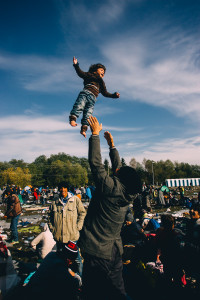 Among the most important manifestations of the Syrian Revolution have been the phenomena of displacement, illegal immigration and asylum and has topped the headlines of Arab and Western news since the second year of the revolution.
Among the most important manifestations of the Syrian Revolution have been the phenomena of displacement, illegal immigration and asylum and has topped the headlines of Arab and Western news since the second year of the revolution.
In addition to the more than 4.5 million refugees, there are 6.5 million Internally Discplaced Peoples (IDPs) who move from their homes to safer areas.
This study aims to shed light on how the new alternative Syrian media addresses these phenomena. We beging this study with a quote from the newspaper “Sourietna” (issue # 110), on the definition of displacement, asylum, and illegal immigration:
“
In demographic studies, migration is defined by movement, whether individually or collectively, from one location to another in search of a better social, economic, religious or political situation. However, in sociology it reflects the change in social circumstances, like a change in profession or social status/class etc.”
Illegal immigration is considered a global phenomenon that exists in advanced countries like the United States and in the European Union, as well as in developing countries in Asia, such as the Arabian Gulf and Levant countries. South American countries like Argentina, Venezuela, and Mexico have also become primary destinations for immigrants coming from neighboring countries. In Africa, where colonially-inherited borders do not at all form insulating barriers for neighboring tribes, especially in some countries like the Ivory Coast or South Africa and Nigeria. It is thus difficult to determine the scale of illegal immigration due to the nature of this phenomena, and the fact that illegal immigrants consist of a mixed variery, including:
- Persons who enter host countries illegally without resolving their legal status.
- Persons who enter host countries legally and stay past the expiration dates of their legal residence.
- Persons who work illegally during their permitted residence.
Displacement
Displacement is the movement of an individual or group of people from one location to another within the borders of the same country. It occurs against the will of the displaced person due to life threatening external factors like famine, war, drought, desertification or any other factors that can cause a person to leave his home to another location out of sheer necessity to escape his or her circumstances.
Asylum
According to law number 45 of the Regulation of Asylum Act of 1974 by the UNHCR, the word refugee includes every person that leaves his country of citizenship for fear of persecution or danger, because of race, religion or membership of a social or political group, or fear of war hostilities, external aggression, occupation, foreign domination, or internal unrest, and one who cannot nor wishes, owing to such fear, to return to his or her country or one who has no nationality but has left the country in which he or she previously resided due to such events and is unwilling and unable to return out of fear. The term refugee also includes children who are not accompanied by adults, who are orphans of war, or those whose parents and guardians disappeared and are found outside the country to which they belong.
The definition of migration is a population movement where an individual or group is relocating from their original country to a new country that is chosen as a result of several reasons. Groups of people resort to smugglers who take them on journeys fraught with danger to reach the shores of Spain, Italy and Greece, or to cross the borders of other countries.
What is the Impetus for Migration?
The developing world is witnessing political and economic crises and social explosions, including civil wars and conflicts, which is considered to be the most prominent reasons that drive its citizens to emigrate. Moreover, there is a sense of political exclusion, the denial of the right to a decent living, and the temptations of immigration. Illegal immigrants face a greater risk of failing into the hands of human trafficking networks and eventual death.
The most prominent international conventions on migration are Agreement 97 (1949), Agreement 143 (1975), and Agreement 111 (1958 by the Internaitonal Labor Organization (ILO) It is worth noting that all of the agreements issued by the ILO aim to protect migrant workers’ rights and aim to provide equal opportunities for them. However, the ILO conventions focus on legal migrant workers and excludes members of a legal migrant’s family or illegal migrant workers at all
Refugee or Migrant: Which is More Consistent with the Point of View of the United Nations High Commissioner for Refugees (UNHCR)?
In recently published news, the UNHCR insisted that people who have arrived in Italy and Greece—who came from countries engulfed by war and are in need of international protection—should continue to be regarded as refugees and not as migrants. They announced that the use of the term refugee is an important distinction because the confusion between the two terms can distract attention away from the specific legal protection that refugees need,. This may lead to the weakening of support for refugees and to the case for asylum at a time when more refugees need this protection more than ever.
Refugee Rights
The newspaper “Souritna”, published an article in issue number 160 to educate refugees on their rights. They released the text of the Declaration of Territorial Asylum (Resolution No. 2312 of 1967), which the United Nations General Assembly adopted that year. It states that every individual has the right to seek refuge in other countries and the right to receive asylum when escaping from persecution. This right cannot be invoked if there are legal prosecutions arising from non-political crimes or from acts contrary to the purposes and principles of the United Nations.
Countries recommend observing the following principles:
• All countries respect the refuge granted by another country, in the exercise of this state’s sovereignty, to persons entitled to the recourse of Article 14 of the Universal Declaration of Human Rights, including those who are struggling against colonialism. In the case where justification is warranted to deviate from this principle the state concerned can review the possibility of granting the person concerned an opportunity to go to another state, either by granting him or her temporary refuge or in another way.
• The situation of the persons referred to should be the main concern of the international community, without disruption to the sovereignty of the host countries.
• If a country faces difficulties in granting and proceeding to grant asylum, other countries must take measures to reduce the burden on that country.
• No person from the referred shall be subjected to measures such as the prevention of entry at the border nor to be subjected to any coerced response or deportation to any country where he or she would be persecuted in the event this person enters the territory where he or she wishes to seek refuge. This principle may not be deviated from except for compelling reasons of national security, or the protection of the population, as in the case of the exponential flow of groups of asylum seekers in massive quantities.
Alternative Media: How Did it Cover the Subjects of Immigration and Asylum?
No smell of Olives and Pickles in Europe (Tala’naAl-Hurrieh)
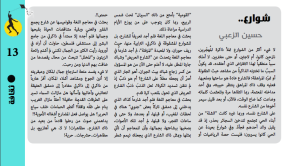 The newspaper “Tala’na Al-Hurrieh” contrasted the media coverage for asylum and displacement. For example, the town Shahba received IDPs from the affected areas is evidence of the unity of the Syrian people (No. 12), while the confrontation of the IDPs of Eastern Ghouta from Douma, ‘Arbin and Harasta to the duality of “death or humiliation” upon their displacement to neighboring towns (No.40).
The newspaper “Tala’na Al-Hurrieh” contrasted the media coverage for asylum and displacement. For example, the town Shahba received IDPs from the affected areas is evidence of the unity of the Syrian people (No. 12), while the confrontation of the IDPs of Eastern Ghouta from Douma, ‘Arbin and Harasta to the duality of “death or humiliation” upon their displacement to neighboring towns (No.40).
Also, on the subject of countries hosting refugees, we find coverage in issues No. 20 and 22 stating “Lebanon, Jordan and Turkey do not differ in their negligence in providing for refugees.” In issue number 32, there was coverage on the restrictions placed on asylum seekers in Egypt in the wake of Morsi’s fall. This change in treatment has been justified due to the view that claims the Syrian revolution is a religious movement in nature, as some Syrians were involved in riots after the removal of Morsi. Moreover, in issue no. 49, coverage on the Kobani refugees in the “Sourouj” Turkish refugee camp is presented.
Live cultural events are held in countries that Syrians have resorted to, as in Germany (No. 61), where refugees feel nostalgic for their homeland. For example, writer Hussein Al-Zoubi (in the same issue number) found a great deal of beauty in Europe but did not smell the aroma of olives and pickles emitted by the local shops they were accustomed to. Their worlds narrowed despite living in an open country.
Moreover, In issue number 23, a field activist meanders in the streets of Ankara, observes the western romance of the young men and women, with hugs and kisses all around, then passes a book vendor which reminds him of al-Halbouni market in beloved Damascus making him ever more nostalgic to Damascus and everything in it.
The Revolution has Become an Aimless Struggle (Hinta)
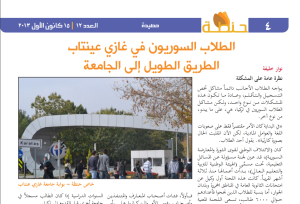 The magazine “Hinta,” issued from “Silmiyeh” a city in the Hama suburbs, has coverage and analysis on the subject of refugees in almost all of it’s issued numbers. In its first issues the magazine focused on “the transformation of Silmiyeh to a primary city of relief and rescue to the people of Hama in 2011,” as it embraced thousands of displaced families from neighboring towns. The residents of Silmiyeh embraced the displaced people and protected them from the People’s Committees after the headquarters were bombed in Silmiyeh.”
The magazine “Hinta,” issued from “Silmiyeh” a city in the Hama suburbs, has coverage and analysis on the subject of refugees in almost all of it’s issued numbers. In its first issues the magazine focused on “the transformation of Silmiyeh to a primary city of relief and rescue to the people of Hama in 2011,” as it embraced thousands of displaced families from neighboring towns. The residents of Silmiyeh embraced the displaced people and protected them from the People’s Committees after the headquarters were bombed in Silmiyeh.”
Eventually coverage on less trending topics that are of interest to the Syrian refugee were featured, which characterized this particular magazine. Such topics included the language barrier for patients in the Gaziantep hospital (No. 10), the long road for Syrian students in Gaziantep University (No. 12), in addition to a crisis of affiliation for refugee children as well as other topics. In issue number 12, the magazine presents the story of four rebels,(one of them a military defector and one a dentist). The military defector and the dentist tell the story of how they left the Revolution but how it still lives in them as an idea,.The third works as an editor of a magazine operating inside and outside of Syria, while the fourth left the revolution because it has become “an aimless struggle” where he will step aside until the cessation of armed conflict. For the writer, the solution to the loss of the revolution to its people is “a clearer vision for everyone, especially the rebels on the ground.”
From a Palestinian to a Syrian Refugees (Souritna)
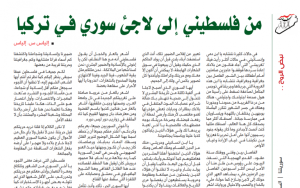 “Souritna” is considered to be one of the most in-depth newspapers with its coverage on the subject of refugees. In nearly all issues it addresses the subject as a prominent feature, which is still minimal coverage for news about asylum, which is being quoted from international and humanitarian agencies and organizations as well as by international news organizations. The newspaper carries out special investigations as well.
“Souritna” is considered to be one of the most in-depth newspapers with its coverage on the subject of refugees. In nearly all issues it addresses the subject as a prominent feature, which is still minimal coverage for news about asylum, which is being quoted from international and humanitarian agencies and organizations as well as by international news organizations. The newspaper carries out special investigations as well.
In issue number 22, an article entitled “Letter from a Palestinian to Syrian Refugees,” where the Palestinian warns Syrians from getting too accustomed to their land of asylum and requests that they return In issue number 54 a group of,refugees discuss “returning, God willing”. Moreover, , the coverage exposes the problems and suffering experienced by Syrian refugees, especially in Lebanon and Jordan. the Lebanese government is heavily blamed for the racism and poor conditions that refugees face. The coverage also blames the military coup in Egypt for the difficulties experienced by the Syrian refugees there.
Zulaikha Salem penned an article in the issue 107 where he wrote “rather than working to find a solution for the Syrian people’s revolution, the Western and European countries allow asylum in their countries for the Syrian intelligentsia, leaving the ongoing war to continue in Syria.” In issue 89, the importance of the role of Syrians abroad in the formation of public opinion among nations is illustrated. Furthermore, in issue 186 there is coverage of how the IDPs were received in Latakia, which was described as sectarianism.
In the coverage of Syrian asylum in Turkey, there is awareness of the easing of legal and economic issues in issue numbers 182 and 183. Conversely, they actively expose the problems experienced by the Syrian refugees in Lebanon and Jordan in particular, and the rest of the countries in general, where the Lebanese government is heavily blamed for the racism and poor conditions that the refugees face.
The Homeland Lost the Refugees Once and for All (Kouluna Souriyoon)
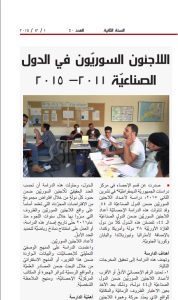 News of asylum, displacement, and migration occupies an article -or more- in the investigation pages of most of the issue numbers of the newspaper. It is noted that the newspaper has held the Kurdish militias responsible for the displacement of the Arabs in some areas and described it as a systematic policy (No. 32). We also find in issue number 40 an article about the fate of the cadre of scholars after the asylum, “Syrians will achieve success in the countries of asylum, but these are individual successes where their homelands have lost them once and for all, for there is no guarantee for the return of refugees to Syria.”
News of asylum, displacement, and migration occupies an article -or more- in the investigation pages of most of the issue numbers of the newspaper. It is noted that the newspaper has held the Kurdish militias responsible for the displacement of the Arabs in some areas and described it as a systematic policy (No. 32). We also find in issue number 40 an article about the fate of the cadre of scholars after the asylum, “Syrians will achieve success in the countries of asylum, but these are individual successes where their homelands have lost them once and for all, for there is no guarantee for the return of refugees to Syria.”
The Regime is Pushing Young People to Migrate (Tamaddun)
Starting from issue number 59 through the latest issue of “Tamaddun” (104), the issue of asylum and displacement was a constant theme.”The regime drives young people to migrate by chasing them to enlist in the army,” said Rama Al-Hurr in issue number 59. We also find coverage on refugees in Al-A’ati refugee camp in issue number 60, and coverage on the health situation of Syrians in Turkey in issue number 62.
Crossing via a Large Pot for Cooking! (Ein Al-Madina):
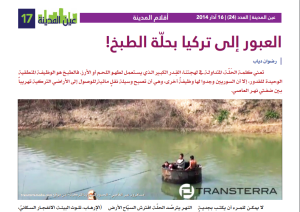 The issue of refugees is not lost on Ein Al-Madina, one of the newspapers that constantly covered refugee matters throughout the issues we followed. Some pieces were humorous, such as “Crossing via a Large Pot for Cooking” in issue no. 24, or “Seven Days Around Syria” in the double issue no. 58-59. The article tells the story of Ahmad, who was “smuggled” into Turkey passing various Kurdish forces, ISIS, the Free Syrian Army, and Islamic brigades We noted that the coverage for the plight of refugees and IDPs declined slightly as more attention was paid to reporting on ISIS, which occupies Deir Ezzour province, the newspaper’s hometown, and which the newspaper considers to be the most pressing issue.
The issue of refugees is not lost on Ein Al-Madina, one of the newspapers that constantly covered refugee matters throughout the issues we followed. Some pieces were humorous, such as “Crossing via a Large Pot for Cooking” in issue no. 24, or “Seven Days Around Syria” in the double issue no. 58-59. The article tells the story of Ahmad, who was “smuggled” into Turkey passing various Kurdish forces, ISIS, the Free Syrian Army, and Islamic brigades We noted that the coverage for the plight of refugees and IDPs declined slightly as more attention was paid to reporting on ISIS, which occupies Deir Ezzour province, the newspaper’s hometown, and which the newspaper considers to be the most pressing issue.
Turkey is one of the Reasons Syrians Suffer (Zaitoun):
Most of Zaitoun’s reports and investigative journalism is on the subject of refugees is considered top-quality. Zaitoun blames Turkey for the suffering of Syrian refugees, which is one of the most striking features of the newspaper. In issue number 67, the paper criticized Turkey’s lack of clear policies in dealing with the refugees, and the impromptu speeches of the Turkish Government in handling the crisis. Similar criticisms can be found in issues no. 77, 88, and 116.
In issue number 80, the paper published an article justifying the perilous sea journey Syrians are making to Europe. In issue no. 40, Zaitoun denounced those Syrians who remain in Syria and criticize those who left. In issue no. 27, we read about Syrian refugees in Zatari Camp yearning to return to Syria, while in issue number 97 the author of an article states “It is easy for Syrian to become westernized; it is impossible for those (who left) to become easternized.”, The article predicts that displaced Syrians most likely will never return to their homes or may not return for decades.
“Western Grapes,” Activities of Syrians Abroad (Enab Baladi):
Enab Baladi’s coverage for the issue of displacement is one of the best among its peers. The paper often titles its last page “Enab Efranji” (Western Grapes), where it sheds light on Syrian civil society activities of in countries where Syrians have sought asylum and exile. The paper also uniquely covered social problems that Syrians face in those countries, as well as problems in education and relief.
Enab Baladi takes a critical stance of Lebanon, Jordan, and Egypt under President Al-Sisi in several issues, while it views Turkey’s treatment of refugees favorably and praises the efforts of the Turkish Government and its people.
The paper considers migration to be a “solution for individuals but problematic for the Syrians left behind. It is better to remain in the fight,” It warns that displacement “is a systematic policy on part of the Syrian regime,” in issues no. 30 and 43, respectively (published at the end of 2012). On the other hand, the paper reported positively on the migration of some activists from the Damascus suburbs to Germany in issue no. 206, as “they still contribute to the revolution or prepare themselves abroad to be able to more sustainably serve the revolution.”
It is worth noting that Enab Baladi uses the term displacement, asylum, and migration interchangeably in several articles. Other newspapers have avoided that error by clarifying the meaning of each term and its legal implication to educate Syrians about their rights.
What Did Editors Say?
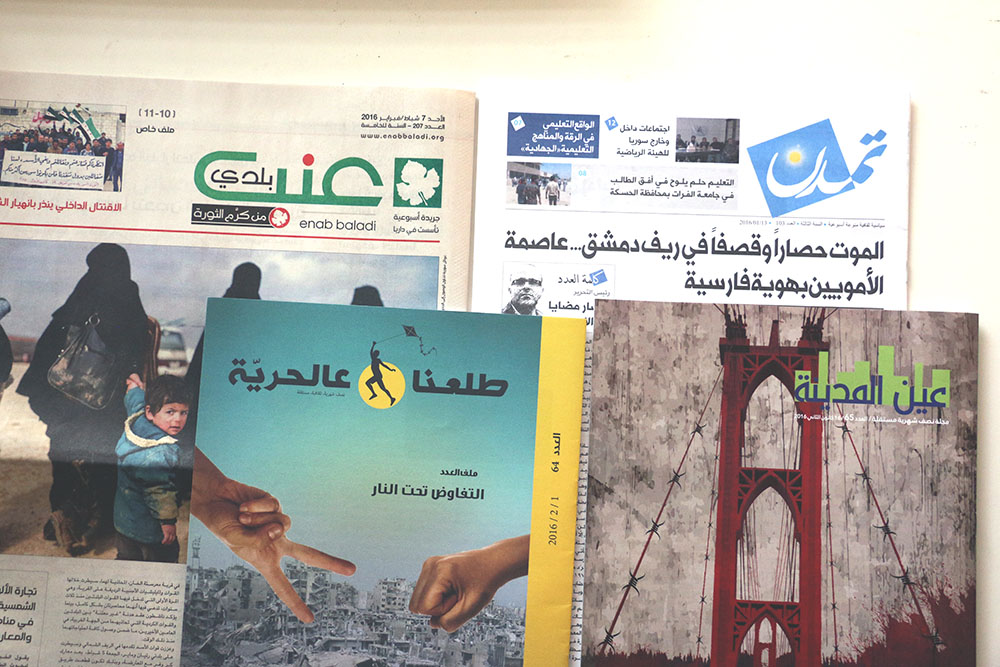 Moral and Humanitarian Commitment Regardless of the Aggressor
Moral and Humanitarian Commitment Regardless of the Aggressor
Laila Safadi, editor of the newspaper“Tala’na Al-Hurrieh”, criticized the lack of media and activist coverage for transgressions against refugees when it comes from a country supportive of the opposition like Turkey. The incident in question is the drowning of a boat full of Syrian refugees by Turkish Border Patrol in the middle of the sea. Ms. Safadi writes that “If our reasoning and foundation is based in human rights, then it should not matter who the aggressor or violator of those rights is— whether it was the regime, ISIS, community protection units or one of the many other forces killing and displacing Syrians.”
Local Situation Imposes Different Priorities:
“Ein Al-Madina” is the only remaining newspaper in the city of Deir Ezzour. Despite the tragedy that a lot of the city’s residents have fled and became refugees, ISIS-related issues have occupied a larger portion of the paper’s coverage. “The amount of coverage is not proportional to the amount of sympathy, of which the paper hasa significant amount . “It depends on finding unique material worth highlighting,” says Tariq Ahmad, Ein Al-Madina’s editor, “and considering the circumstances of our province, which is considered one of ISIS’s strong holds, we find it better to report on this situation, trying to analyze and expose ISIS’s weakness to the public.”
Alternative Media Newspapers are Other Victims of Displacement:
“ The newspaper Tamaddun was established in asylum countries, specifically in Turkey and Lebanon,” says Diab Sarria, the paper’s editor illustrating the effects of displacement on his paper’s origin. “It started as a website named ‘Domino,’ which aimed to report on civil activism and demonstrations in Syria. After we were repeatedly harassed by security forces and the revolution evolved into an armed uprising, and due to a lack of funding, we left Syria to neighboring asylum countries. There we decided to launch ‘Tamddun’ to reflect the civic side of the revolution and affirm its initial values.”
Leaving Syria and settling in an asylum country was not without problems for Tamaddun. The first problem is the “criticism our newspaper faces by Turkey. The Turks are arrogant, they encourage secularism and criticize religion. Moreover, there is a general sentiment shared by Syrians to a point of near-consensus, that those who left the country have no right to speak for those who remained.”
These problems seem to be more manageable compared to the most recent dilemma, one that neither Tamaddun nor its peers have been able to solve. The newspapers’ writers and journalists continue to leave for Europe. “After the migration of talented youth from Syria into neighboring countries, a new phase began with their immigration to Europe, causing the paper to rapidly lose employees. These journalists had received two years of training . We are unable to find replacements.”
Mr. Sarria believes that the large numbers of refugees arriving in Europe have led European Relief Organizations to prioritize supporting those refugees over supporting alternative media, “which caused the paper to temporarily move to bi-weekly instead of weekly publications, unfortunately.”
The newspaper Souritna faced similar problems. The paper’s editor, Jawad Abu Al-Muna says they lost three full-time and two freelance journalists. He added “it is not stable working with alternative media newspapers for over three months. And that is a best-case scenario. We do not have a long-term strategies because of the financial conditions and reliance on donors, and because of the many legal hurdles we face in Turkey. We tried as much as we could to provide a relatively stabile situaiton for our employees, but this is has proven extremely difficult considering our unstable funding.”
The majority of Enab Baladi’s staff has had to leave Darya, the paper’s hometown, to various asylum countries. Nonetheless, the paper was able to overcome a lot of the problems created by the displacement crises, which several newspapers continue to face, according to its editor, Jawad Sherbaji. He explains that Enab Baladi has not been visibly affected, and that its workforce is stable and permanent. Mr. Sherbaji addsed “I believe the reason for this stability is the presence of an organizational structure that provides guarantees to employees, such as contracting, a compensation and incentive program, and proper work conditions. All of which have enabled us, to this day, to avoid the hurdles faced by peer institutions.”
To Summarize
With varying reporting quality, the issues of asylum and migration have occupied a large share of coverage in Syrian new alternative media. It is worth noting that sometimes they take up nearly half of a newspaper, or they are the subject of a regular column, a series of articles, or special coverage. The issue of displacement receives less coverage, to the point of neglect, in all of the newspapers we examined, especially since the beginning of 2013. A possible explanation is the fact that most IDPs move to areas under regime control, which makes it difficult to cover their situation.
We also noted that forces other than the regime and its loyal militias are hardly ever blamed for the displacement of Syrian civilians. For example, in the news coverage we followed, the Free Syrian Army was never blamed for taking over new cities and towns. Neither Kurdish forces nor ISIS were blamed for the plight of Syrian refugees.
Finally, we found that the newspapers we covered largely ignored the propaganda perpetrated by the Syrian regime against refugees. Such propaganda aims to criticize refugees by claiming they have no loyalty and do not yearn for their country,. The “right of return” referencing the Palestinian tragedy, is the ideal analogy.
International institutions must support Syrian alternative media before they suffer more as a result of the displacement crisis. The best investment in our opinion is to support these alternative media organizations, to legally and financially support the staff so that they may continue their journalistic work, whether in Syria or in neighboring countries.
As for newspapers that were able to avert the negative effects of displacement on their performance, we believe it is their duty to share their experiences with peer organizations. The sustainability of these papers strengthens the voice of a civic and democratic society in Syria, and the fall of any one of them will have adverse consequences on the mission of all.
Most Important Events Related to Refugees Since the Beginning of the Revolution From March 2011 until November 2015:
- April 2011: 5000 Syrians living near the Lebanese border sought refuge in Lebanon.
- June 2011: Thousands of Syrian left Jisr Al-Shughur for Turkey. The Syrian regime’s propaganda aimed to tarnish their image.
- July 2011: The first groups of Syrians arrive as refugees in Jordan.
- April 2012: The first refuge camp is established in Iraqi Kurdistan.
- July 2012: 200,000 civilians fled Aleppo. Thousands moved to Turkey. Za’atari Camp was established in Jordan to house 113,000 refugees.
- September 2012: Demonstrations in Za’atari Camp. More than 6,000 refugees left the camp and returned to Syria.
- January 2013: Snowstorms and cold weather in refugee camps cause extreme hardship. 12 refugees are confirmed dead due to hypothermia.
- September 2013: The number of Syrian refugees exceeds 2 million. Germany promises to resettle 5,000 Syrian refugees. Sweden announces its plan to offer permanent residency to Syrian refugees.
- November 2013: A television report exposes military operations on behalf of Greece to observe refugees in the Mediterranean Sea and prevent them from completing their journey. Bulgaria builds a fence around its border with turkey.
- December 2013: A large-scale polio vaccination campaign takes place in and around Syria.
- February 2014: Various news organizations report on the story of Marwan, the four-year-old child who crossed the border to Jordan by himself. The U.N. warns that 10,000 Syrian children are in danger of death due malnutrition in refugee camps in Lebanon.
- March 2014: A video starring a British child and depicting the suffering of refugee children stirs international debate about refugees.
- June 2014: Declaration of the founding of the Islamic State in Iraq and Syria. 1.2 million Iraqis flee their homes, including half a million Iraqis from the city of Mosul.
- September 2014: 130,000 Kurds flee to Turkey following confrontation with ISIS.
- October 2014: Lebanon closes its borders to Syrian refugees.
- April 2014: At least 800 refugees died as their boat capsized in the Mediterranean. The month of April set the highest ever-recorded number of deaths of refugees in the Mediterranean.
- July 2015: 50,000 refugees arrive in Greece. Hungary builds a fence around its border with Serbia. The EU agrees to accept 32,000 refugees from Greece and Italy.
- August 2015: The bodies of 71 Syrian refugees are found in an abandoned tractor-trailer on the side of the road in Austria. 156,000 refugees enter Europe during the month of August, reaching 500,000 by the end of the year.
- September 2015: The picture of Aylan Kurdy sparks international outcry. Aylan was a three-year-old toddler who died at sea and whose tiny body washed on the Turkish shore. A few days later, Britain agreed to accept 20,000 new refugees, France to accept 24,000. Germany dedicates 6 million Euros to spend on resettling 800,000 refugees.
- November 2015: The coordinated terrorist attacks in Paris lead to the death of over 100 civilians. ISIS claims responsibility. Right-wing parties in Europe increase rhetoric against refugees.
if you think the article contain wrong information or you have additional details Send Correction
-
Follow us :


















 A
A
A
A
A
A



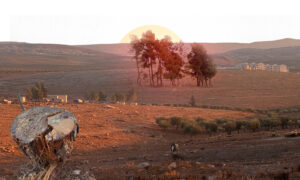
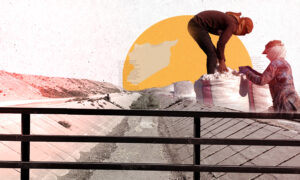

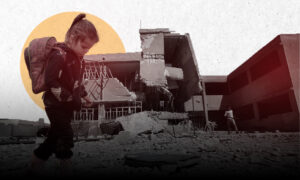
 More In-Depth
More In-Depth